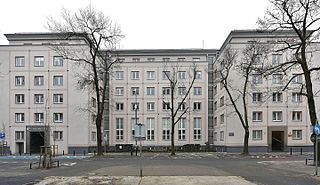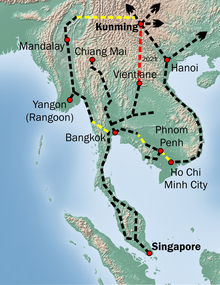
Transport in Pakistan is extensive and varied. In recent years, new national highways have been built, with the addition of motorways which have improved trade and logistics within the country. Pakistan's rail network is also undergoing expansion in recent years. Airports and seaports have been built with the addition of foreign and domestic funding. Transportation challenges in Pakistan are escalating due to poor planning, inadequate governance, and corrupt practices.

A transcontinental railroad or transcontinental railway is contiguous railroad trackage that crosses a continental land mass and has terminals at different oceans or continental borders. Such networks may be via the tracks of a single railroad, or via several railroads owned or controlled by multiple railway companies along a continuous route. Although Europe is crisscrossed by railways, the railroads within Europe are usually not considered transcontinental, with the possible exception of the historic Orient Express. Transcontinental railroads helped open up interior regions of continents not previously colonized to exploration and settlement that would not otherwise have been feasible. In many cases, they also formed the backbones of cross-country passenger and freight transportation networks. Many of them continue to have an important role in freight transportation, and some such as the Trans-Siberian Railway even have passenger trains going from one end to the other.

In rail transport, track gauge is the distance between the two rails of a railway track. All vehicles on a rail network must have wheelsets that are compatible with the track gauge. Since many different track gauges exist worldwide, gauge differences often present a barrier to wider operation on railway networks.

The Eurasian Land Bridge, sometimes called the New Silk Road, is the rail transport route for moving freight and passengers overland between Pacific seaports in the Russian Far East and China and seaports in Europe. The route, a transcontinental railroad and rail land bridge, comprises the Trans-Siberian Railway, which runs through Russia and is sometimes called the Northern East-West Corridor, and the New Eurasian Land Bridge or Second Eurasian Continental Bridge, running through China and Kazakhstan. As of November 2007, about one percent of the $600 billion in goods shipped from Asia to Europe each year were delivered by inland transport routes.

Pakistan Railways is the state-owned railway operator in Pakistan. Founded in 1861 as the North Western State Railway and headquartered in Lahore, it owns 7,789 kilometres of operational track across Pakistan, stretching from Peshawar to Karachi, offering both freight and passenger services, covering 482 operational stations across Pakistan.

With railways, a break of gauge occurs where a line of one track gauge meets a line of a different gauge. Trains and rolling stock generally cannot run through without some form of conversion between gauges, leading to passengers having to change trains and freight requiring transloading or transshipping; this can add delays, costs, and inconvenience to travel on such a route.

The Islamic Republic of Iran Railways is the national state-owned railway system of Iran. The Raja Passenger Train Company is an associate of the IR, and manages its passenger trains. The Railway Transportation Company is an associate of the IR, which manages its freight transport. The Ministry of Roads & Urban Development is the state agency that oversees the IRIR. Some 33 million tonnes of goods and 29 million passengers are transported annually by the rail transportation network, accounting for 9 percent and 11 percent of all transportation in Iran, respectively (2011).
Qazaqstan Temır Joly is the national railway company of Kazakhstan.

Dostyk or Druzhba is a small town in Kazakhstan's Jetisu Region, on the border with Xinjiang, China. It is a port of entry from China. The rail portion serves as an important link in the Eurasian Land Bridge. It is situated in the Dzungarian Gate, a historically significant mountain pass.

Turkey has a state-owned railway system built to standard gauge which falls under the remit of the Ministry of Transportation and Infrastructure. The primary rail carrier is the Türkiye Cumhuriyeti Devlet Demiryolları (TCDD) which is responsible for all long-distance and cross-border freight and passenger trains. A number of other companies operate suburban passenger trains in urban conurbations.

Afghanistan has four railway lines in the north and northwest of the country. The first is between Mazar-i-Sharif and the border town of Hairatan in Balkh province, which then connects with Uzbek Railways of Uzbekistan. The second links Torghundi in Herat province with Turkmen Railways of Turkmenistan. The third is between Turkmenistan and Aqina in Faryab province of Afghanistan, which extends south to the city of Andkhoy. The country currently lacks a passenger rail service, but a new rail link from Herat to Khaf in Iran for both cargo and passengers was recently completed. Passenger service is also proposed in Hairatan – Mazar-i-Sharif section and Mazar-i-Sharif – Aqina section.

5 ft 6 in (1,676 mm) is a broad track gauge, used in India, Pakistan, western Bangladesh, Sri Lanka, Argentina, Chile, and on BART.

Rail transport in Myanmar consists of a 6,207.644 km (3,857 mi) railway network with 960 stations. The network, generally spanning north to south with branch lines to the east and west, is the second largest in Southeast Asia, and includes the Yangon Circular Railway which serves as a commuter railway for Yangon, the principal commercial city in Myanmar. The quality of the railway infrastructure is generally poor. The tracks are in poor condition, and are not passable during the monsoon season. The speed of freight trains is heavily restricted on all existing links as a consequence of poor track and bridge conditions. The maximum speed for freight trains has been quoted as 24 km/h (15 mph), suggesting that commercial speeds on this section could be as low as 12–14 km/h (7.5–8.7 mph).

The Organisation for Co‑operation between Railways, is an organization established as the equivalent of the International Union of Railways (UIC) to create and improve the coordination of international rail transport.< Concerning especially the transports between Europe and Asia, it has helped develop cooperation between railway companies and with other international organisations. The members of this organisation created an international transport law.
Gede is the last railway station on the Indian side of the Bangladesh–India border in Krishnaganj CD Block in Nadia district in the Indian state of West Bengal. The corresponding station on the Bangladesh side is Darshana. It is the terminal station on the Sealdah–Gede section of Kolkata Suburban Railway system. There is a border checkpoint at Gede.
Transmountain railroads are railroads that need to cross dauntingly high mountain ranges to cross between countries on one side to the other. The Himalayan Mountains, Andes and the Alps would be cases in point. Because of construction difficulties, some such railways are yet to be built. With globalisation and trade liberalisation, the economic viability of constructing of these railways is improving.

Azerbaijan Railways is the national state-owned rail transport operator in the Republic of Azerbaijan. The 2,918 km (1,813 mi), 1,520 mm gauge network is electrified at 3 kV (3,000 V) DC. The headquarters of the Azerbaijan Railways is in the capital Baku.
Mahisasan is a border railway station and a defunct railway transit facility point on the India–Bangladesh border in Karimganj district in the Indian state of Assam. The corresponding station on the Bangladesh side is Shahbajpur in Sylhet District. The border station is linked to Karimganj 11 kilometres (6.8 mi) away. The Mahisasan–Shahbajpur route has not been operational since December, 1996 due to lack of traffic.

Attari Shyam Singh Railway Station is located in Amritsar district in the Indian state of Punjab and serves Attari and the Wagah border with Pakistan.

Zahedan Railway Station is located in Zahedan, Iran. It serves as the terminus for the Quetta–Taftan Railway Line and Bam-Zahedan railway. It also serves as the break of gauge between Pakistan Railways 1,676 mm broad gauge and Islamic Republic of Iran Railways 1,435 mmstandard gauge. It is one of the three stations in Iran which are served by Pakistan Railways.















